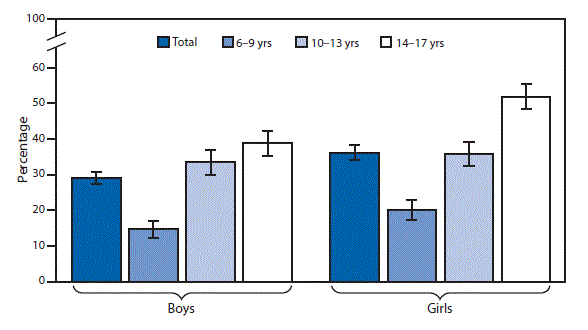 MMWR Weekly Vol. 66, No. 34 September 1, 2017 PDF of this issue |
QuickStats: Percentage* of Children Aged 6–17 Years Who Wear Glasses or Contact Lenses,† by Sex and Age Group — National Health Interview Survey, 2016§
Weekly / September 1, 2017 / 66(34);917

* With 95% confidence intervals indicated with error bars.
† Based on the survey response of “yes” to the question “Does (child’s name) wear eyeglasses or contact lenses?” Children who are blind were excluded from these estimates.
§ Estimates are based on household interviews of a sample of the civilian, noninstitutionalized U.S. population and are derived from the National Health Interview Survey Sample Child component.
In 2016, the percentage of children aged 6–17 years who wear eyeglasses or contact lenses was higher among girls (36.2%) compared with boys (29.1%). Girls aged 6–9 years (20.2%) and 14–17 years (51.9%) were more likely than boys of the same age group (14.9% and 38.8%, respectively) to wear eyeglasses or contact lenses. There was no statistically significant difference by sex for children aged 10–13 years (35.9% among girls, 33.5% among boys). Among both girls and boys, children aged 14–17 years were most likely to wear eyeglasses or contact lenses, and children aged 6–9 years were least likely to wear eyeglasses or contact lenses.
Source: National Center for Health Statistics. National Health Interview Survey, 2016. https://www.cdc.gov/nchs/nhis.htm.
Reported by: Lindsey I. Black, MPH, lblack1@cdc.gov, 301-458-4548.






















.png)











No hay comentarios:
Publicar un comentario